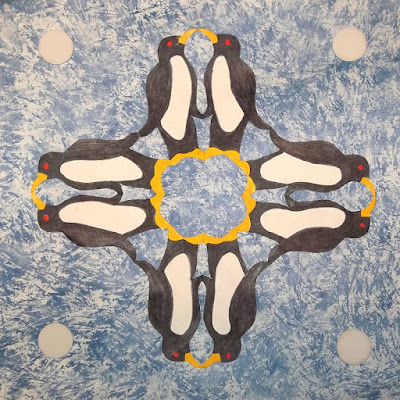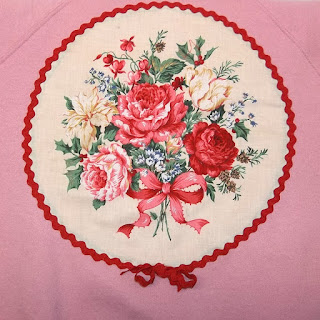 |
| A 'doodle' becomes a snowflake cross-stitch pattern |
How do you develop complicated patterns like the A-B-C-D-E-F progression on the “Serendipity” post (January 15, 2017)?
I like to “doodle”; that is, to draw designs and little pictures while I take a coffee break, talk on the telephone, or watch television. A lot of people do that. The difference is that I like to do my drawing on a pad of graph paper, rather than on plain paper. I draw randomly until a combination of lines or shapes appeals to me. Then I start repeating that motif in different combinations. A geometric pattern just grows out from its center, as you saw in the example you mentioned. Curved designs are harder, as are realistic pictures, and may need to be be moved to plain paper for further development. I keep a lot of my “doodles” — even the ones that didn't turn out the way that I wanted them to do. I can always return to them, revise them, and improve them. If you are a “doodler” too, get a pad of graph paper and start working on patterns of your own. In the meantime, here is another progression (what a good name for it) that you might like. Instead of showing the steps separately, I have shown the steps in different colors, starting with a simple ‘X’ in a square.
Can the border at the top of the Serendipity blog be done in Swedish weaving?
I'm glad you asked that because it is something I hadn't thought about. It can't be duplicated exactly, and the pattern will not be as bold because it is done with floss instead of yarn, but a very similar pattern can be done and the positions and placements of the colors can certainly be duplicated. The needlepoint stitches are all slanted, while the weaving stitches may be straight stitches in any direction; they may even be looped stitches. The white background on the needlepoint must be filled with stitches. This is not necessary with the weaving, where the fabric background provides the white spacing. Finally, the weaving is done entirely on the surface of the fabric, while the needlepoint covers both the front and back of the canvas. You can see my pattern below. I really like the result. It would be attractive as a border or as repeated stripes on something like an afghan. I hope you like it as much as I do. Since you asked about Swedish weaving, I assume you are familiar with the technique and have probably used it. If not, you might want to read the posts for March 11, 2016; March 31, 2016; and
October 31, 2016.
 |
| Swedish weaving sample, after the needlepoint from the "Serendipity" post |
For those of you who like step-by-step directions for this pattern, those will be in a post in early March, after our annual anniversary post. We have had so many good questions and requests for additional help that we will need to do a special “Question and Answer” post to cover all of them. I'm so pleased when I can give additional help. Just keep watching for it.
I like the little animals at the bottom of the Serendipity article, but I don't understand how I am supposed to embroider them??? HELP!
 |
| Little animal cross-stitch patterns |
First, let me “translate” them into cross-stitch patterns with back-stitch borders. Each square in the original design represents a cross-stitch (X) or a half cross-stitch (/ or \). A quarter cross-stitch extends from a corner to the middle of the stitch area. Because white pencil does not scan well, the white stitches are drawn in standard pencil. Refer to the original pictures for more information. Work all full, half, and quarter cross-stitches — including ones in black — before beginning the back-stitch outlines, which are done in black. If you embroider the designs on monks' cloth, Aida, or any even-weave fabric, they will be smaller than they appear on these charts. The smaller they are, the fewer strands of floss should be used.
Tip: The eyes of the owl are done in horizontal stitches or satin stitch. The beak may also be done in satin stitch. The nostrils are tiny French knots. The cat is shown in gray, but could just as easily be white, black, orange, yellow, or brown. Whiskers might be added in single strands of black or white thread.
For those of you who wanted additional help with doing the animals in needlepoint, that will be given in the March post also.
Do four-way designs have to be geometric designs?
The short answer is: Certainly not! The long answer is: an upcoming blog post for mid-March! I hope quilters and those of you who do pencil-and-paper art will enjoy this one as much as needlepointers and embroiderers. There is a "teaser" below.
Stitch away,

 |
| A distinctly non-geometric four-way design |
 This post by Annake's Garden is licensed under a Creative Commons Attribution-NonCommercial-ShareAlike 3.0 Unported License.
This post by Annake's Garden is licensed under a Creative Commons Attribution-NonCommercial-ShareAlike 3.0 Unported License.




 This post by Annake's Garden is licensed under a Creative Commons Attribution-NonCommercial-ShareAlike 3.0 Unported License.
This post by Annake's Garden is licensed under a Creative Commons Attribution-NonCommercial-ShareAlike 3.0 Unported License.



